Opportunities and Challenges in the Australian Food Sector Analysis
VerifiedAdded on 2023/06/10
|8
|1550
|455
Report
AI Summary
This report analyzes the current state of the Australian food market, focusing on the growing functional food sector. It discusses the increasing demand for plant-based foods, alternative proteins, free-from foods, and functional foods, highlighting both the opportunities and challenges faced by companies in this sector due to government regulations on formulation, labeling, and advertising. Using Porter's Five Forces framework, the report examines competitive rivalry, the threat of new entrants and substitute products, and the bargaining power of suppliers and buyers. The analysis concludes that while the sector is highly profitable, companies face challenges related to the supply of food components, but the demand for nutritional food is consistently growing, indicating a promising future for the functional food market in Australia.

Running head: CHALLENGES AND OPPORTUNITIES IN FOOD SECTOR
CHALLENGES AND OPPORTUNITIES IN FOOD SECTOR
name of the student:
name of University:
Author's note:
CHALLENGES AND OPPORTUNITIES IN FOOD SECTOR
name of the student:
name of University:
Author's note:
Paraphrase This Document
Need a fresh take? Get an instant paraphrase of this document with our AI Paraphraser
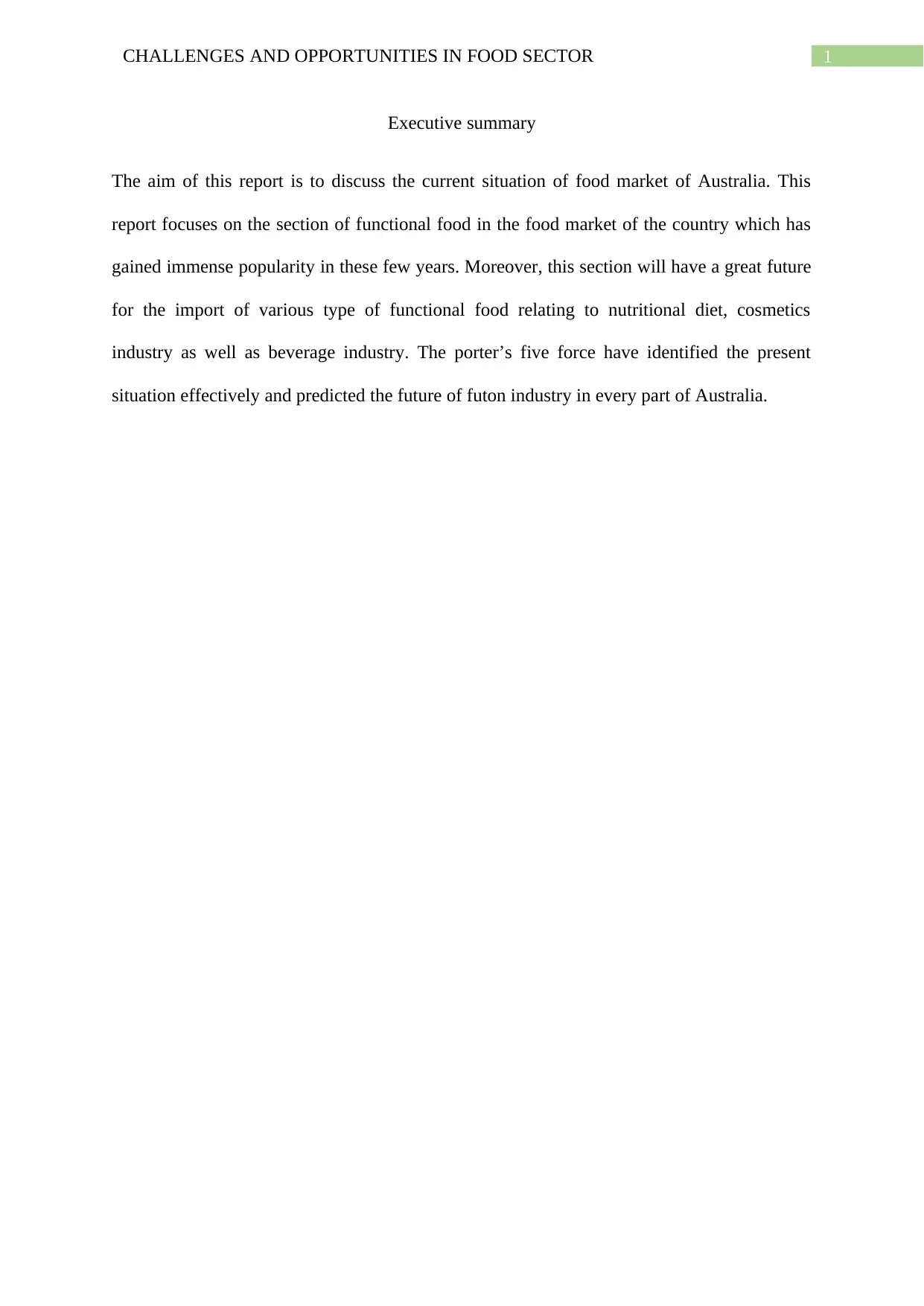
1CHALLENGES AND OPPORTUNITIES IN FOOD SECTOR
Executive summary
The aim of this report is to discuss the current situation of food market of Australia. This
report focuses on the section of functional food in the food market of the country which has
gained immense popularity in these few years. Moreover, this section will have a great future
for the import of various type of functional food relating to nutritional diet, cosmetics
industry as well as beverage industry. The porter’s five force have identified the present
situation effectively and predicted the future of futon industry in every part of Australia.
Executive summary
The aim of this report is to discuss the current situation of food market of Australia. This
report focuses on the section of functional food in the food market of the country which has
gained immense popularity in these few years. Moreover, this section will have a great future
for the import of various type of functional food relating to nutritional diet, cosmetics
industry as well as beverage industry. The porter’s five force have identified the present
situation effectively and predicted the future of futon industry in every part of Australia.
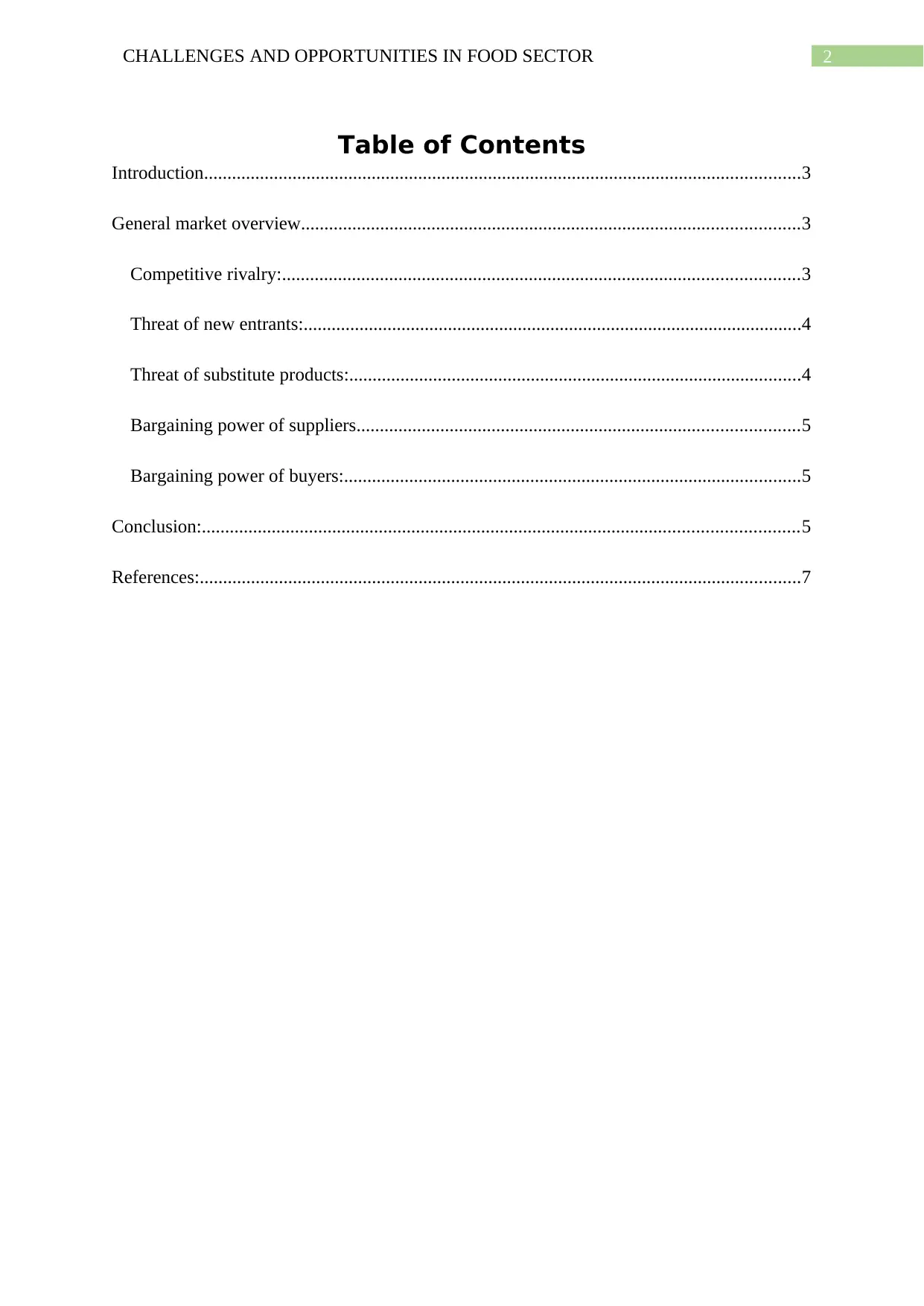
2CHALLENGES AND OPPORTUNITIES IN FOOD SECTOR
Table of Contents
Introduction................................................................................................................................3
General market overview...........................................................................................................3
Competitive rivalry:...............................................................................................................3
Threat of new entrants:...........................................................................................................4
Threat of substitute products:.................................................................................................4
Bargaining power of suppliers...............................................................................................5
Bargaining power of buyers:..................................................................................................5
Conclusion:................................................................................................................................5
References:.................................................................................................................................7
Table of Contents
Introduction................................................................................................................................3
General market overview...........................................................................................................3
Competitive rivalry:...............................................................................................................3
Threat of new entrants:...........................................................................................................4
Threat of substitute products:.................................................................................................4
Bargaining power of suppliers...............................................................................................5
Bargaining power of buyers:..................................................................................................5
Conclusion:................................................................................................................................5
References:.................................................................................................................................7
⊘ This is a preview!⊘
Do you want full access?
Subscribe today to unlock all pages.

Trusted by 1+ million students worldwide
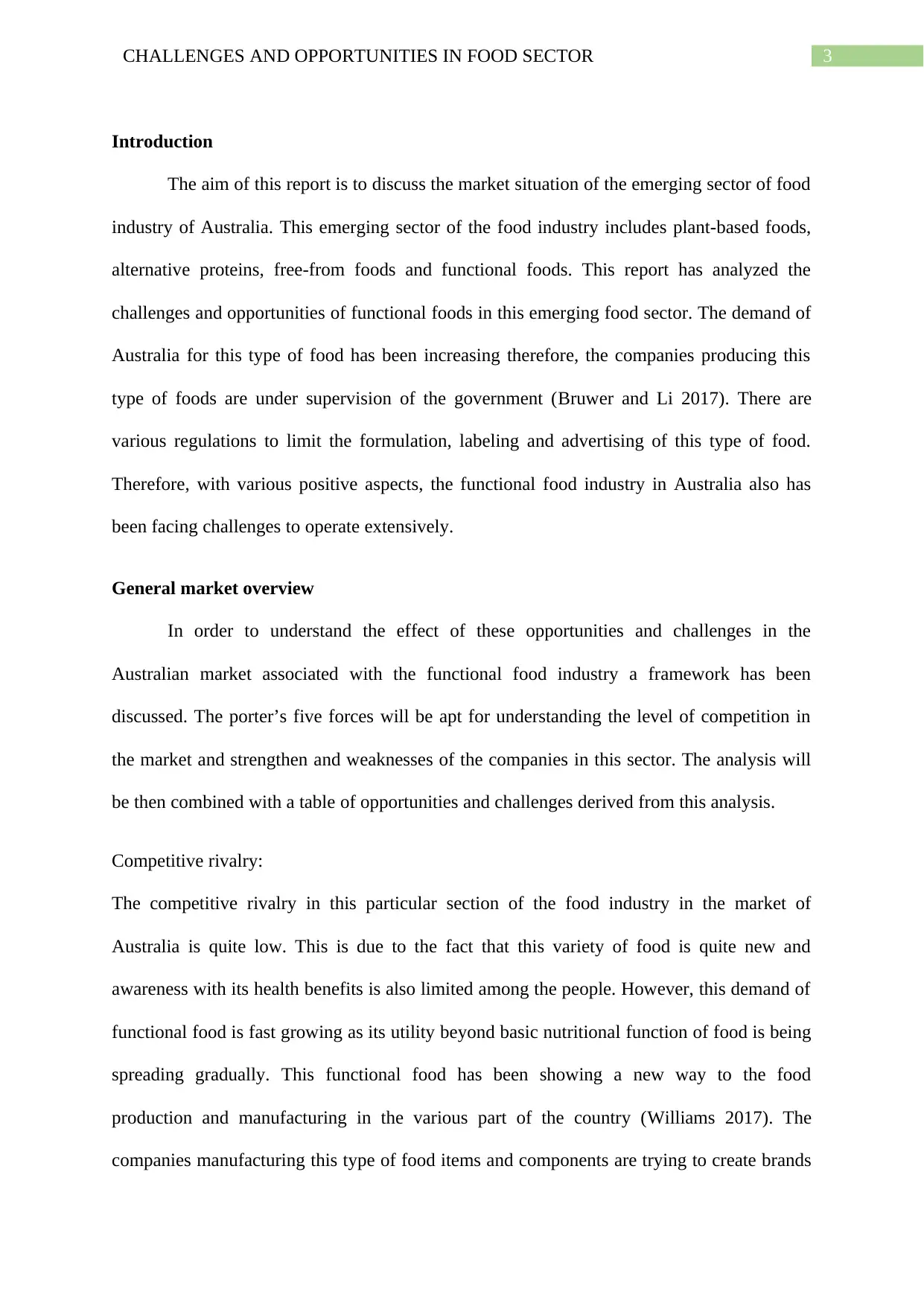
3CHALLENGES AND OPPORTUNITIES IN FOOD SECTOR
Introduction
The aim of this report is to discuss the market situation of the emerging sector of food
industry of Australia. This emerging sector of the food industry includes plant-based foods,
alternative proteins, free-from foods and functional foods. This report has analyzed the
challenges and opportunities of functional foods in this emerging food sector. The demand of
Australia for this type of food has been increasing therefore, the companies producing this
type of foods are under supervision of the government (Bruwer and Li 2017). There are
various regulations to limit the formulation, labeling and advertising of this type of food.
Therefore, with various positive aspects, the functional food industry in Australia also has
been facing challenges to operate extensively.
General market overview
In order to understand the effect of these opportunities and challenges in the
Australian market associated with the functional food industry a framework has been
discussed. The porter’s five forces will be apt for understanding the level of competition in
the market and strengthen and weaknesses of the companies in this sector. The analysis will
be then combined with a table of opportunities and challenges derived from this analysis.
Competitive rivalry:
The competitive rivalry in this particular section of the food industry in the market of
Australia is quite low. This is due to the fact that this variety of food is quite new and
awareness with its health benefits is also limited among the people. However, this demand of
functional food is fast growing as its utility beyond basic nutritional function of food is being
spreading gradually. This functional food has been showing a new way to the food
production and manufacturing in the various part of the country (Williams 2017). The
companies manufacturing this type of food items and components are trying to create brands
Introduction
The aim of this report is to discuss the market situation of the emerging sector of food
industry of Australia. This emerging sector of the food industry includes plant-based foods,
alternative proteins, free-from foods and functional foods. This report has analyzed the
challenges and opportunities of functional foods in this emerging food sector. The demand of
Australia for this type of food has been increasing therefore, the companies producing this
type of foods are under supervision of the government (Bruwer and Li 2017). There are
various regulations to limit the formulation, labeling and advertising of this type of food.
Therefore, with various positive aspects, the functional food industry in Australia also has
been facing challenges to operate extensively.
General market overview
In order to understand the effect of these opportunities and challenges in the
Australian market associated with the functional food industry a framework has been
discussed. The porter’s five forces will be apt for understanding the level of competition in
the market and strengthen and weaknesses of the companies in this sector. The analysis will
be then combined with a table of opportunities and challenges derived from this analysis.
Competitive rivalry:
The competitive rivalry in this particular section of the food industry in the market of
Australia is quite low. This is due to the fact that this variety of food is quite new and
awareness with its health benefits is also limited among the people. However, this demand of
functional food is fast growing as its utility beyond basic nutritional function of food is being
spreading gradually. This functional food has been showing a new way to the food
production and manufacturing in the various part of the country (Williams 2017). The
companies manufacturing this type of food items and components are trying to create brands
Paraphrase This Document
Need a fresh take? Get an instant paraphrase of this document with our AI Paraphraser
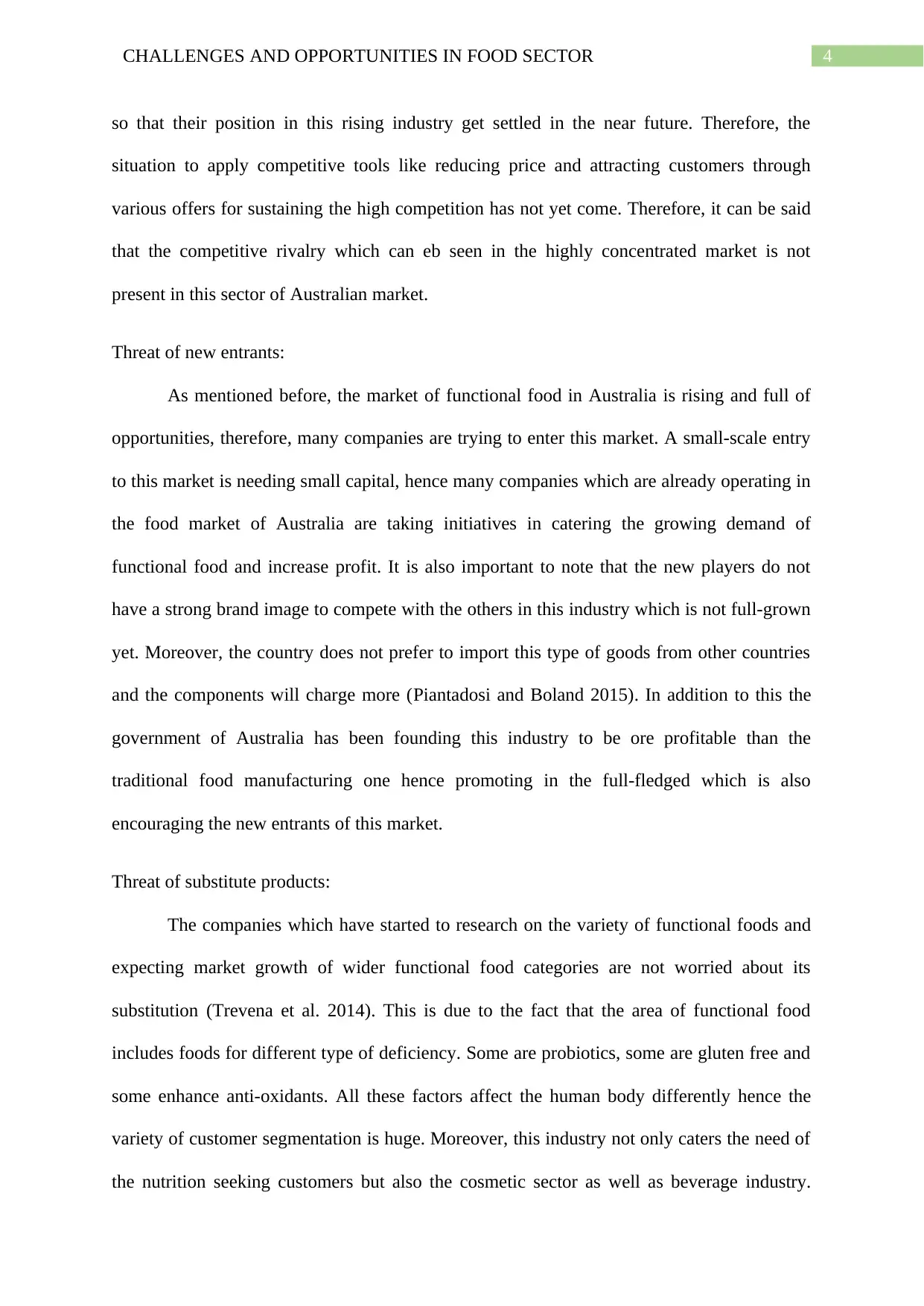
4CHALLENGES AND OPPORTUNITIES IN FOOD SECTOR
so that their position in this rising industry get settled in the near future. Therefore, the
situation to apply competitive tools like reducing price and attracting customers through
various offers for sustaining the high competition has not yet come. Therefore, it can be said
that the competitive rivalry which can eb seen in the highly concentrated market is not
present in this sector of Australian market.
Threat of new entrants:
As mentioned before, the market of functional food in Australia is rising and full of
opportunities, therefore, many companies are trying to enter this market. A small-scale entry
to this market is needing small capital, hence many companies which are already operating in
the food market of Australia are taking initiatives in catering the growing demand of
functional food and increase profit. It is also important to note that the new players do not
have a strong brand image to compete with the others in this industry which is not full-grown
yet. Moreover, the country does not prefer to import this type of goods from other countries
and the components will charge more (Piantadosi and Boland 2015). In addition to this the
government of Australia has been founding this industry to be ore profitable than the
traditional food manufacturing one hence promoting in the full-fledged which is also
encouraging the new entrants of this market.
Threat of substitute products:
The companies which have started to research on the variety of functional foods and
expecting market growth of wider functional food categories are not worried about its
substitution (Trevena et al. 2014). This is due to the fact that the area of functional food
includes foods for different type of deficiency. Some are probiotics, some are gluten free and
some enhance anti-oxidants. All these factors affect the human body differently hence the
variety of customer segmentation is huge. Moreover, this industry not only caters the need of
the nutrition seeking customers but also the cosmetic sector as well as beverage industry.
so that their position in this rising industry get settled in the near future. Therefore, the
situation to apply competitive tools like reducing price and attracting customers through
various offers for sustaining the high competition has not yet come. Therefore, it can be said
that the competitive rivalry which can eb seen in the highly concentrated market is not
present in this sector of Australian market.
Threat of new entrants:
As mentioned before, the market of functional food in Australia is rising and full of
opportunities, therefore, many companies are trying to enter this market. A small-scale entry
to this market is needing small capital, hence many companies which are already operating in
the food market of Australia are taking initiatives in catering the growing demand of
functional food and increase profit. It is also important to note that the new players do not
have a strong brand image to compete with the others in this industry which is not full-grown
yet. Moreover, the country does not prefer to import this type of goods from other countries
and the components will charge more (Piantadosi and Boland 2015). In addition to this the
government of Australia has been founding this industry to be ore profitable than the
traditional food manufacturing one hence promoting in the full-fledged which is also
encouraging the new entrants of this market.
Threat of substitute products:
The companies which have started to research on the variety of functional foods and
expecting market growth of wider functional food categories are not worried about its
substitution (Trevena et al. 2014). This is due to the fact that the area of functional food
includes foods for different type of deficiency. Some are probiotics, some are gluten free and
some enhance anti-oxidants. All these factors affect the human body differently hence the
variety of customer segmentation is huge. Moreover, this industry not only caters the need of
the nutrition seeking customers but also the cosmetic sector as well as beverage industry.
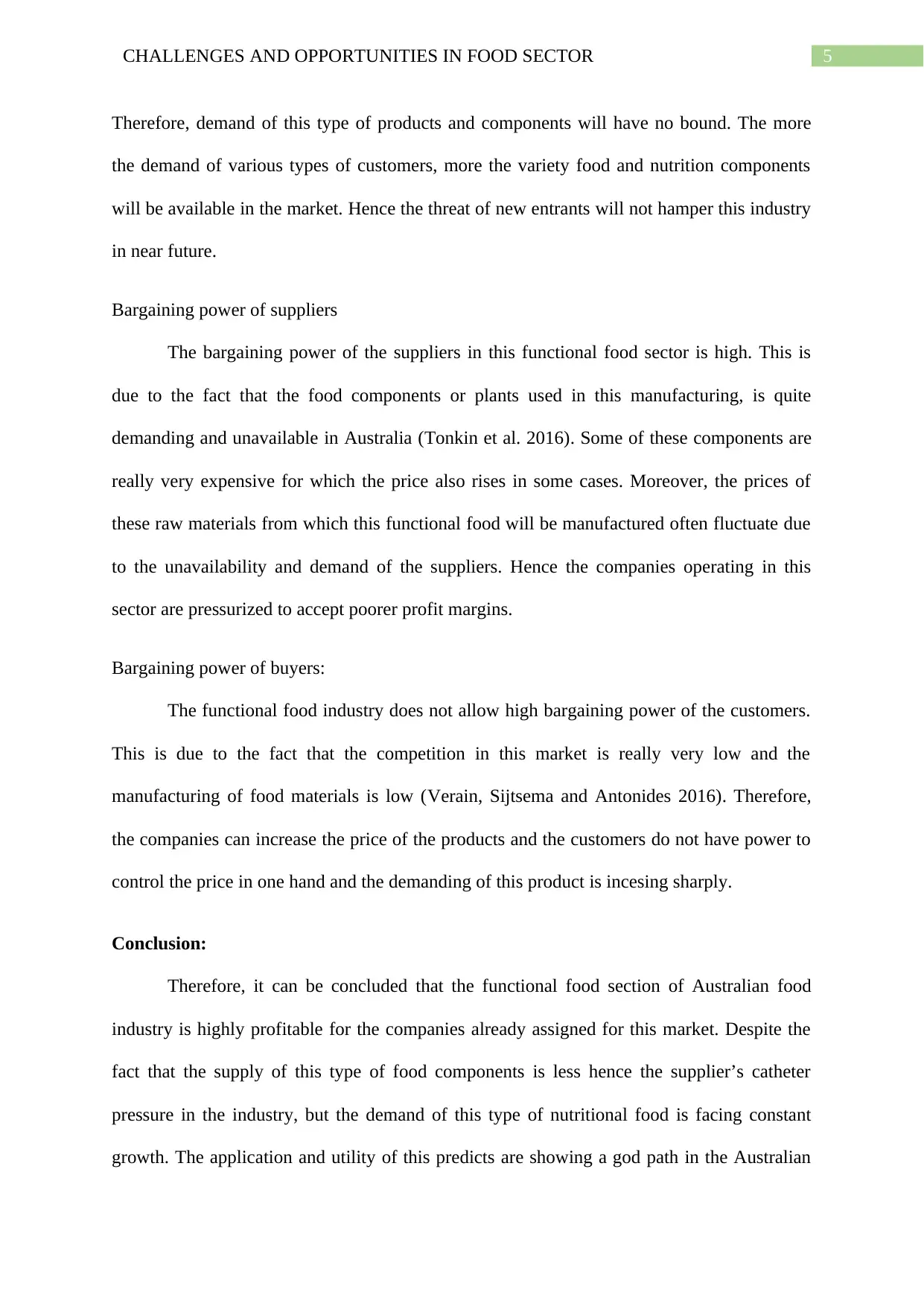
5CHALLENGES AND OPPORTUNITIES IN FOOD SECTOR
Therefore, demand of this type of products and components will have no bound. The more
the demand of various types of customers, more the variety food and nutrition components
will be available in the market. Hence the threat of new entrants will not hamper this industry
in near future.
Bargaining power of suppliers
The bargaining power of the suppliers in this functional food sector is high. This is
due to the fact that the food components or plants used in this manufacturing, is quite
demanding and unavailable in Australia (Tonkin et al. 2016). Some of these components are
really very expensive for which the price also rises in some cases. Moreover, the prices of
these raw materials from which this functional food will be manufactured often fluctuate due
to the unavailability and demand of the suppliers. Hence the companies operating in this
sector are pressurized to accept poorer profit margins.
Bargaining power of buyers:
The functional food industry does not allow high bargaining power of the customers.
This is due to the fact that the competition in this market is really very low and the
manufacturing of food materials is low (Verain, Sijtsema and Antonides 2016). Therefore,
the companies can increase the price of the products and the customers do not have power to
control the price in one hand and the demanding of this product is incesing sharply.
Conclusion:
Therefore, it can be concluded that the functional food section of Australian food
industry is highly profitable for the companies already assigned for this market. Despite the
fact that the supply of this type of food components is less hence the supplier’s catheter
pressure in the industry, but the demand of this type of nutritional food is facing constant
growth. The application and utility of this predicts are showing a god path in the Australian
Therefore, demand of this type of products and components will have no bound. The more
the demand of various types of customers, more the variety food and nutrition components
will be available in the market. Hence the threat of new entrants will not hamper this industry
in near future.
Bargaining power of suppliers
The bargaining power of the suppliers in this functional food sector is high. This is
due to the fact that the food components or plants used in this manufacturing, is quite
demanding and unavailable in Australia (Tonkin et al. 2016). Some of these components are
really very expensive for which the price also rises in some cases. Moreover, the prices of
these raw materials from which this functional food will be manufactured often fluctuate due
to the unavailability and demand of the suppliers. Hence the companies operating in this
sector are pressurized to accept poorer profit margins.
Bargaining power of buyers:
The functional food industry does not allow high bargaining power of the customers.
This is due to the fact that the competition in this market is really very low and the
manufacturing of food materials is low (Verain, Sijtsema and Antonides 2016). Therefore,
the companies can increase the price of the products and the customers do not have power to
control the price in one hand and the demanding of this product is incesing sharply.
Conclusion:
Therefore, it can be concluded that the functional food section of Australian food
industry is highly profitable for the companies already assigned for this market. Despite the
fact that the supply of this type of food components is less hence the supplier’s catheter
pressure in the industry, but the demand of this type of nutritional food is facing constant
growth. The application and utility of this predicts are showing a god path in the Australian
⊘ This is a preview!⊘
Do you want full access?
Subscribe today to unlock all pages.

Trusted by 1+ million students worldwide
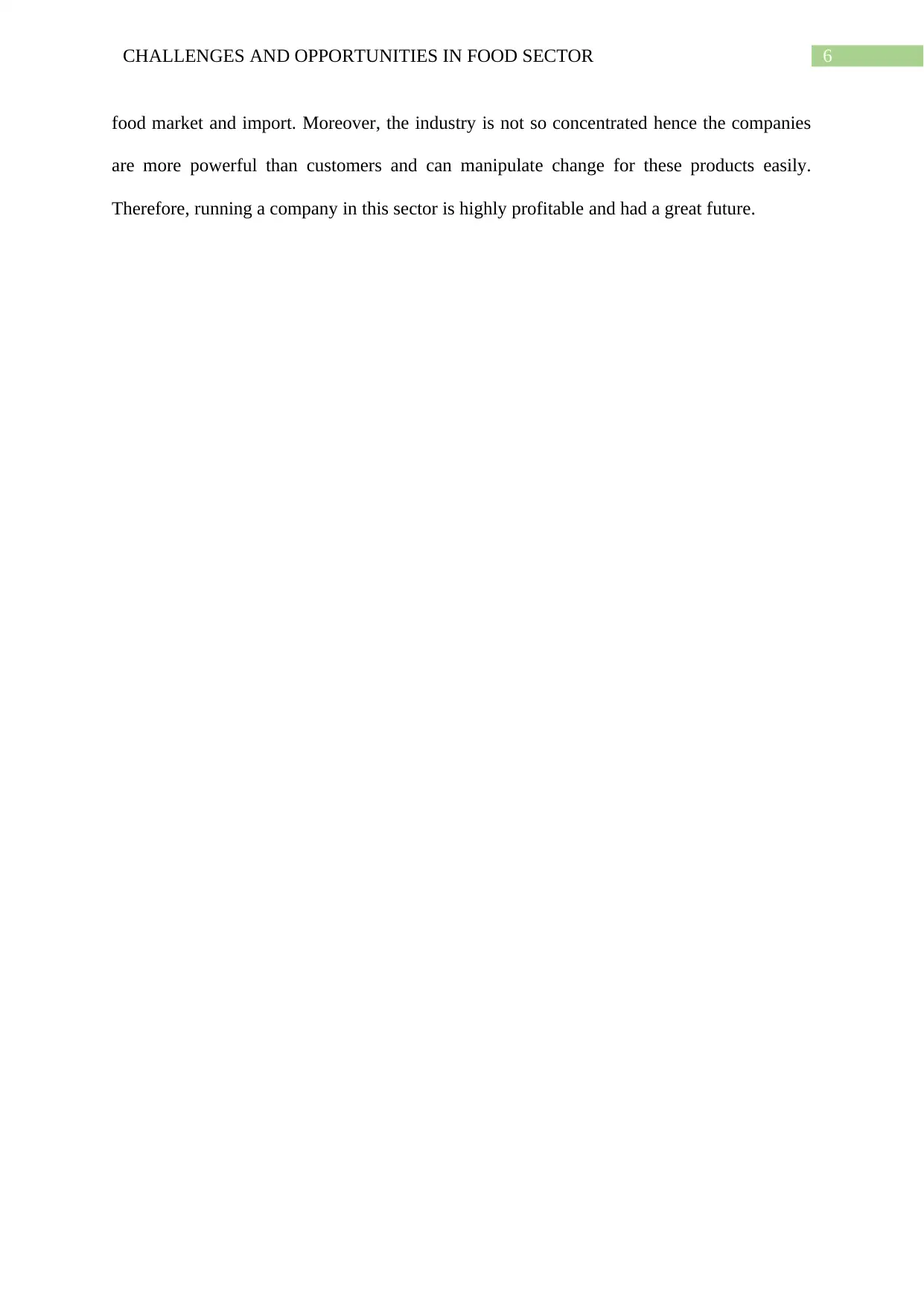
6CHALLENGES AND OPPORTUNITIES IN FOOD SECTOR
food market and import. Moreover, the industry is not so concentrated hence the companies
are more powerful than customers and can manipulate change for these products easily.
Therefore, running a company in this sector is highly profitable and had a great future.
food market and import. Moreover, the industry is not so concentrated hence the companies
are more powerful than customers and can manipulate change for these products easily.
Therefore, running a company in this sector is highly profitable and had a great future.
Paraphrase This Document
Need a fresh take? Get an instant paraphrase of this document with our AI Paraphraser
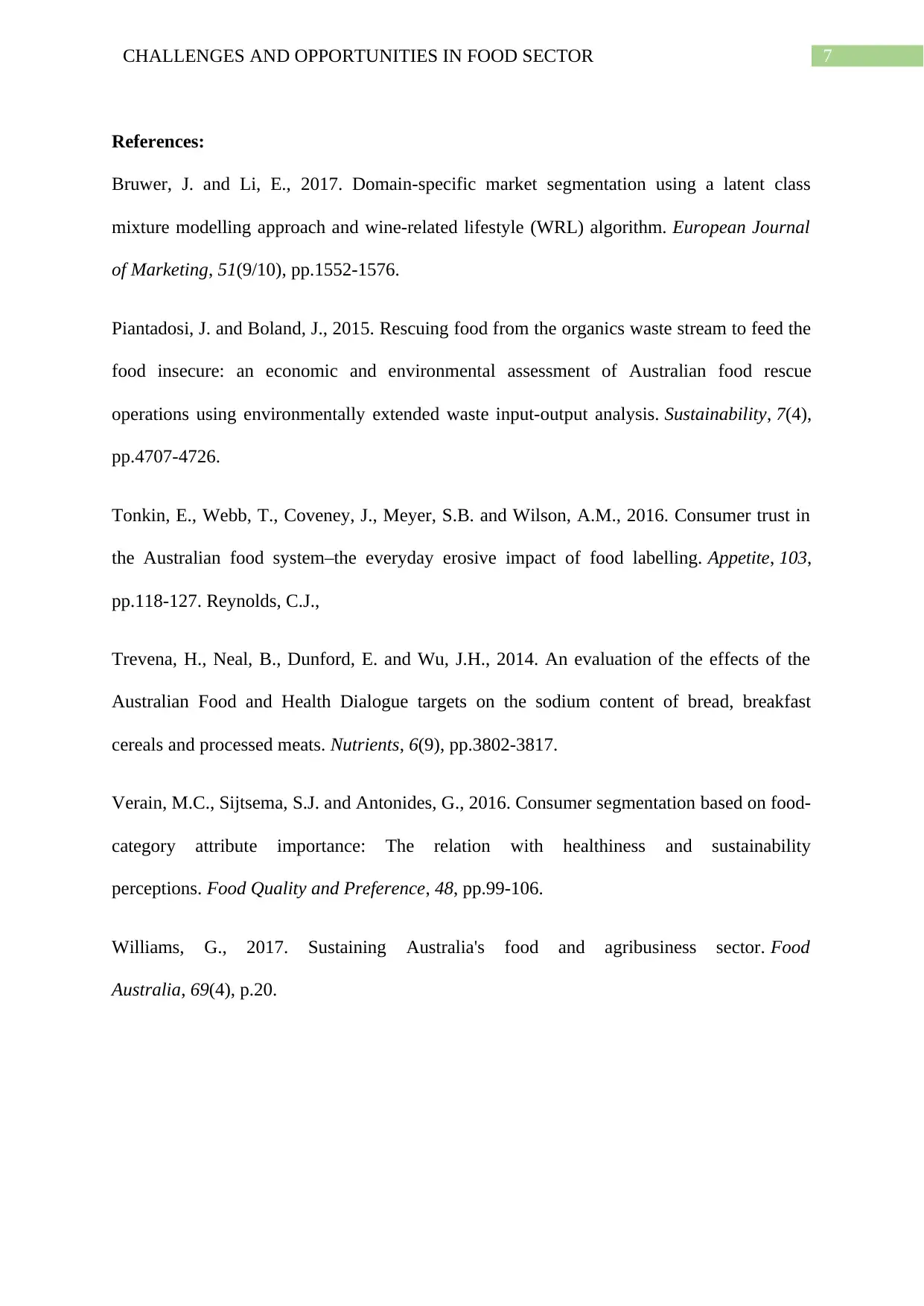
7CHALLENGES AND OPPORTUNITIES IN FOOD SECTOR
References:
Bruwer, J. and Li, E., 2017. Domain-specific market segmentation using a latent class
mixture modelling approach and wine-related lifestyle (WRL) algorithm. European Journal
of Marketing, 51(9/10), pp.1552-1576.
Piantadosi, J. and Boland, J., 2015. Rescuing food from the organics waste stream to feed the
food insecure: an economic and environmental assessment of Australian food rescue
operations using environmentally extended waste input-output analysis. Sustainability, 7(4),
pp.4707-4726.
Tonkin, E., Webb, T., Coveney, J., Meyer, S.B. and Wilson, A.M., 2016. Consumer trust in
the Australian food system–the everyday erosive impact of food labelling. Appetite, 103,
pp.118-127. Reynolds, C.J.,
Trevena, H., Neal, B., Dunford, E. and Wu, J.H., 2014. An evaluation of the effects of the
Australian Food and Health Dialogue targets on the sodium content of bread, breakfast
cereals and processed meats. Nutrients, 6(9), pp.3802-3817.
Verain, M.C., Sijtsema, S.J. and Antonides, G., 2016. Consumer segmentation based on food-
category attribute importance: The relation with healthiness and sustainability
perceptions. Food Quality and Preference, 48, pp.99-106.
Williams, G., 2017. Sustaining Australia's food and agribusiness sector. Food
Australia, 69(4), p.20.
References:
Bruwer, J. and Li, E., 2017. Domain-specific market segmentation using a latent class
mixture modelling approach and wine-related lifestyle (WRL) algorithm. European Journal
of Marketing, 51(9/10), pp.1552-1576.
Piantadosi, J. and Boland, J., 2015. Rescuing food from the organics waste stream to feed the
food insecure: an economic and environmental assessment of Australian food rescue
operations using environmentally extended waste input-output analysis. Sustainability, 7(4),
pp.4707-4726.
Tonkin, E., Webb, T., Coveney, J., Meyer, S.B. and Wilson, A.M., 2016. Consumer trust in
the Australian food system–the everyday erosive impact of food labelling. Appetite, 103,
pp.118-127. Reynolds, C.J.,
Trevena, H., Neal, B., Dunford, E. and Wu, J.H., 2014. An evaluation of the effects of the
Australian Food and Health Dialogue targets on the sodium content of bread, breakfast
cereals and processed meats. Nutrients, 6(9), pp.3802-3817.
Verain, M.C., Sijtsema, S.J. and Antonides, G., 2016. Consumer segmentation based on food-
category attribute importance: The relation with healthiness and sustainability
perceptions. Food Quality and Preference, 48, pp.99-106.
Williams, G., 2017. Sustaining Australia's food and agribusiness sector. Food
Australia, 69(4), p.20.
1 out of 8
Related Documents
Your All-in-One AI-Powered Toolkit for Academic Success.
+13062052269
info@desklib.com
Available 24*7 on WhatsApp / Email
![[object Object]](/_next/static/media/star-bottom.7253800d.svg)
Unlock your academic potential
Copyright © 2020–2025 A2Z Services. All Rights Reserved. Developed and managed by ZUCOL.





